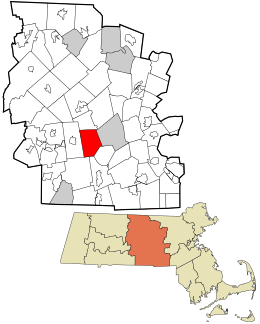Leicester, Massachusetts
| Leicester, Massachusetts | ||
|---|---|---|
| Town | ||

Leicester Town Hall
|
||
|
||
 Location in Worcester County and the state of Massachusetts. |
||
| Coordinates: 42°14′45″N 71°54′33″W / 42.24583°N 71.90917°WCoordinates: 42°14′45″N 71°54′33″W / 42.24583°N 71.90917°W | ||
| Country | United States | |
| State | Massachusetts | |
| County | Worcester | |
| Settled | 1713 | |
| Incorporated | 1714 | |
| Government | ||
| • Type | Open town meeting | |
| • Town Administrator | Kevin Mizikar | |
| • Board of Selectmen | Douglas Belanger (Chair) (terms ends 2018) Harry Brooks(Vice Chair)(2018) Thomas Buckley III (2nd Vice Chair) (2017) Dianna Provencher (2017) Michael J. Shivick, Esq. (2019) |
|
| • Superintendent of Schools | Judith J. Paolucci | |
| • School Committee | Paul McCarthy (Chair) Scott Francis (Vice Chair) Stella Richards (Secretary) Tom Lauder Grover Adams |
|
| Area | ||
| • Total | 24.7 sq mi (63.9 km2) | |
| • Land | 23.4 sq mi (60.5 km2) | |
| • Water | 1.3 sq mi (3.4 km2) | |
| Elevation | 1,009 ft (308 m) | |
| Population (2010) | ||
| • Total | 10,970 | |
| • Density | 440/sq mi (170/km2) | |
| Time zone | Eastern (UTC-5) | |
| • Summer (DST) | Eastern (UTC-4) | |
| ZIP code | 01524, 01542, 01611 | |
| Area code(s) | 508 / 774 | |
| FIPS code | 25-34795 | |
| GNIS feature ID | 0619483 | |
| Website | http://www.leicesterma.org/ | |
Leicester /ˈlɛstər/ is a village in Worcester County, Massachusetts, United States. The population was 10,970 at the 2010 census.
Leicester was first settled in 1713 and was officially incorporated in 1714. The town was named after Robert Dudley, 1st Earl of Leicester.
One of the early settlers in town was a Dr. Samuel Green. He lived at 2 Charlton St., in Greenville (which is now part of Rochdale, a village in Leicester). Samuel Green lived in a house at 2 Charlton Street. He was a doctor who trained many other doctors in the early 1700s. This constituted the first medical school in Massachusetts. The Green family was involved in the creation of both Worcester's Green Hill Park and New York City's Central Park.
Although no significant battles of the American Revolution were fought in the area, Leicester citizens played a large role in the conflict's start. At a Committee of Safety meeting in 1774, Leicester's Colonel William Henshaw declared that "we must have companies of men ready to march upon a minute's notice"—coining the term "minutemen", a nickname for the militia members who fought in the revolution's first battles. Henshaw would later become an adjutant general to Artemas Ward, who was second in command to George Washington in the Continental Army.
Before the British troops marched to Lexington and Concord, looking for the ammunition and equipment held by the Americans, that ammunition and equipment was moved further West to four locations in the town of Leicester, including the house Dr. Green built at 2 Charlton Street. This information can be found in books held on reserve in the Leicester Public Library. When they heard that the British had attacked, Leicester's own Minutemen gathered on Leicester Common. They marched quickly to join with other Minutemen on April 19, 1775, to fight at the first conflict between Massachusetts residents and British troops, the Battles of Lexington and Concord. A few months later on June 17, 1775, a freed slave and Leicester resident named Peter Salem fought at the Battle of Bunker Hill, where he killed British Major John Pitcairn. Both men are memorialized in Leicester street names (Peter Salem Road, Pitcairn Avenue), as is Colonel Henshaw (Henshaw Street).
...
Wikipedia

